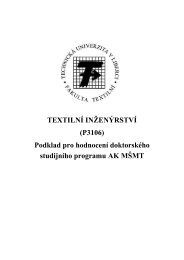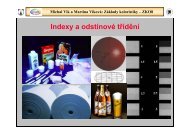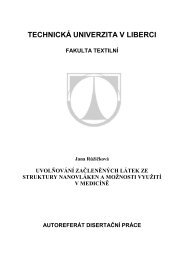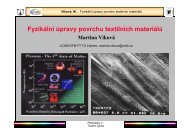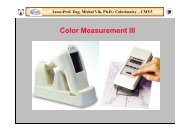You also want an ePaper? Increase the reach of your titles
YUMPU automatically turns print PDFs into web optimized ePapers that Google loves.
<strong>Hyaluronic</strong> <strong>Acid</strong>: Structure, Propertiesand ApplicationsLubomír Lapčík, Jr.Institute of Physics and Material Engineering, Faculty of TechnologyTomas Bata University in Zlín, nám T.G. Masaryka 275, CZ-762 72 Zlín, Czech RepublicE-mail: lapcik@ft.utb.cz, WWW.ft.utb.cz/czech/UFMI
IntroductionCivilization can be described as a historical complexity of the mutualrelation and interconnections of applied materials:stone age,copper, bronze,ironAnd the present era? … Paper, synthetic polymers, specialmaterials, silicon, or composites?Current technical civilizationis based on several pillars:EnergyCommunicationsInformationsEducationMaterials2
Types of network structuresDivided according to the length of cross-links: Atomic networks Molecular networksAccording to the character of the bonds: Covalent networks Physical networks Topologicaly entangled networks Combined covalent and physical networks3
Polymeric networks Are based on molecular networks. Structure and properties of polymericnetworks are not determined by mutualinteraction between atoms or moleculeswhich are creating connecting points,but depends on structure and length ofthe secondary chains of the network. If the secondary chains are long enough and their chemicalstructure allows adopting of configurations of various rotationaldegrees of freedom, they are creating soft, elastic, so calledelastomeric materials. Rigid secondary chains cause creation of the hard, glassymaterials.6
Mechanical properties of polymeric networksNetwork can be deformed, it remains as solid matter and does not undergoflow, exhibits infinity value of viscosity at steady shear stress.CrosslinkPolymeric chainGel at fast loadingGel in relaxed stateRef.: M. Sato, W.H. Schwartz, T.D. Pollard: Nature, 325, (1987), 828.Gel at slow loading7
Polymeric networks In the case, when network structure iscreated only by physical interactionsbetween linear molecules, theconnecting points create more so calledconnecting regions, of connecting zones. These than create ordered (e.g. helical,mutually intertwined structures), or onlytopological intertwined chains. These inthe case of hydrogen bonds create at theordinary conditions permanent networks,which are exhibiting only elastomericbehavior.Left-hand twisted Right-hand twistedhelixhelix8
Gel systemsGel definition:In 19. century Graham as a first introduced term „hydrosole“ and „hydrogel“.P.W. Atkins: „A gel is a semirigid mass of a lyphilic sol in which all thedispersion medium has penetrated into the sol particles“.J. Pouchlý and I. Vavruch: „A gel is a dispersed system created bycontinuous dispersed phase penetrated by continuous dispersing phase“.P.J. Flory: „Only and nearly universal property of gels is their physicochemicalbehavior as a solid matter. When they are deformed, theirresponse is identical with response of elastic body, while the elasticmodulus has a low value “.J.D. Ferry: „Gels are highly diluted systems which are not exhibitingsimple steady shear flow “.9
Gel systemsGel definition:Newtonian Non-NewtonianSwelling rheol.rheol. abbility behaviorF. Burchard and S.B. Ross-Murphy: „Gels are substances which exhibitwide enough plateau region of the real part of the complex modulus, whilein the plateau region must be the value of the real part of G´(ω) minimumten times higher in magnitude than its imaginary part G´´(ω) to allow gelexhibit behavior of the solid body and become elastic “.J´´J´Ref.: Lapčík L., Dammer Ch., Valko M.:Colloid Polym. Sci., 270, (1992), 1049.Lapčík L., Lapčík L., Staško A., Valko M.: SKPatent 277 976 (1995).10
Gel systemsGel definition:Newtonian Non-NewtonianSwelling rheol.rheol. abbility behaviorF. Burchard and S.B. Ross-Murphy: „Gels are substances which exhibitwide enough plateau region of the real part of the complex modulus, whilein the plateau region must be the value of the real part of G´(ω) minimumten times higher in magnitude than its imaginary part G´´(ω) to allow gelexhibit behavior of the solid body and become elastic “.J´´J´ J´J´´Ref.: Lapčík L., Dammer Ch., Valko M.:Colloid Polym. Sci., 270, (1992), 1049.Lapčík L., Lapčík L., Staško A., Valko M.: SKPatent 277 976 (1995).11
Gel systemsDevided according to structural criteria:1. Lamelar structures: well ordered, including gel mesophases.2. Covalent polymeric networks: are completely disordered.3. Polymeric networks created by physical aggregation: are mostlydisordered, contain regions with local order.4. Particular gels: create disordered structures.12
Gelation of polymersIs influenced by:1. Mutual polymer/polymer interaction.2. Thermodynamic conditions, which lead more to the creation ofthe network, then to the precipitation of agregating molecules.Particular connections can be created due to:Floryho and Hugginstheory Crosslinking in the course of polymerization reaction (e.g. by condensationor addition polymerization). Covalent polymeric networks Decreasing of the polymer solubility in solution, i.e. by partialseparation of particular phases.⎛φAφBχ∆G=⎜mixRTV lnφA+ lnφB+ φ⎝νAνBνCA⎞φ⎟B⎠13
Gelation of polymersConnecting points create so calledconnecting regions, or connecting zones.Physical polymeric networksCan be distinguished: One, two and three-dimensional connectingpoints – Fig. 1(a). Mutual entanglements, or bonds betweenseparated regions of higher polymerconcentration, when produced networkcreate continual phase – Fig. 1(b). Geometrical entanglements of molecules(various topological entangl.) – Fig. 1(c). Crystallization – Fig. 2.(a) – foulded chain,(b) – fringe – micellar,(c) – extended chain.Obr. 1.Obr. 2.14
Natural biomaterials application Intelligent materials Polymeric surfaces<strong>Hyaluronic</strong> acid (hyaluronate)Lit.: Lapčík L. et al.: CZ Patent Pending 2001-1975, (2001).Chabreček P. et al.: PCT Int. Appl. WO 9620796 (1996), WO 9406485 (1994), WO 9620919(1996), Eur. Pat. 632329 (1995), US Pats. 5612389 (1997) a US Pat. Pat. 5612391 (1997).Lapčík L. et al.: SK Patent 277 976 (1995).Lapčík L., Lapčík L., DeSmedt S., Demeester J., Chabreček P.: Chem. Rev., 98, (1998), 2663.15
Natural biomaterials application Intelligent materials Polymeric surfaces<strong>Hyaluronic</strong> acid (hyaluronate)Lit.: Lapčík L. et al.: CZ Patent Pending 2001-1975, (2001).Chabreček P. et al.: PCT Int. Appl. WO 9620796 (1996), WO 9406485 (1994), WO 9620919(1996), Eur. Pat. 632329 (1995), US Pats. 5612389 (1997) a US Pat. Pat. 5612391 (1997).Lapčík L. et al.: SK Patent 277 976 (1995).Lapčík L., Lapčík L., DeSmedt S., Demeester J., Chabreček P.: Chem. Rev., 98, (1998), 2663.16
Intelligent polymeric surfaces/interfacesBiocompatibilization by biopolymer attachmentDiffuse Dielectric meassurements relaxation spectroscopy by ATR FTIR methodAbs. band area λ max 3390 cm -1 (rel. units)40003500300025002000150010005000conductivityrelaxationHA0 25 50 75 100 125 150Swelling time (s) Atelocollagen I Sodium hyaluronate602K 2O 2S 3K 3O 3SS am ple lab ellin gLit.: Peterková P., Lapčík L.: Coll. Polym. Sci., 278, (2000), 1014.Liederman K., Lapčík L.: Carbohydrate Polymers, 42 (4), 369-374 (2000).Peterková P., Lapčík L.: J. Polym. Mat., (2002), v tisku.Lapčík L., Peterková P., Lapčík L., Gheorghiu M.: CZ Patent Pending 2001-1975, (2001).Peeling Strength (N/m)50403020100HECNew type of hybridecomposite materialsImplantsSubtrates for growth of cellsHemostatic wrapingmaterialsGel Form of Matter as a Foundation of MaterialEngineering Elements 17
Intelligent polymeric surfaces/interfacesBiocompatibilization by biopolymer attachmentDiffuse Dielectric meassurements relaxation spectroscopy by ATR FTIR methodAbs. band area λ max 3390 cm -1 (rel. units)40003500300025002000150010005000conductivityrelaxationHA0 25 50 75 100 125 150Swelling time (s) Atelocollagen I Sodium hyaluronate602K 2O 2S 3K 3O 3SS am ple lab ellin gLit.: Peterková P., Lapčík L.: Coll. Polym. Sci., 278, (2000), 1014.Liederman K., Lapčík L.: Carbohydrate Polymers, 42 (4), 369-374 (2000).Peterková P., Lapčík L.: J. Polym. Mat., (2002), v tisku.Lapčík L., Peterková P., Lapčík L., Gheorghiu M.: CZ Patent Pending 2001-1975, (2001).Peeling Strength (N/m)50403020100HECNew type of hybridecomposite materialsImplantsSubtrates for growth of cellsHemostatic wrapingmaterialsGel Form of Matter as a Foundation of MaterialEngineering Elements 18
Intelligent polymeric surfaces/interfacesBiocompatibilization by biopolymer attachmentDiffuse Dielectric meassurements relaxation spectroscopy by ATR FTIR method4000ParametrVzorek3500conductivity3000HA Na + CHS2500C HECrelaxationCMC200010 3 × (ω S- ω ∞) 2,06 4,8015002,30 37,650α × β 0,84 1,17 0,68 0,60401010 -3 τ 0(s) 1,0 3,4 5,1 68,102K 2O 2S 3K 3O 3SS am ple lab ellin gLit.: Peterková P., Lapčík L.: Coll. Polym. Sci., 278, (2000), 1014.Liederman K., Lapčík L.: Carbohydrate Polymers, 42 (4), 369-374 (2000).Peterková P., Lapčík L.: J. Polym. Mat., (2002), v tisku.Lapčík L., Peterková P., Lapčík L., Gheorghiu M.: CZ Patent Pending 2001-1975, (2001).Abs. band area λ max 3390 cm -1 (rel. units)1000500Peeling Strength (N/m)0603020HA 2,2α 0,73 0,29 0,68 0,600,970 25 50 75 100 125 150Swelling time (s)0,97HEC3,8A 3 × 10 -18 6 × 10 -22 1 × 10 -18 3 × 10 -19 Atelocollagen I Sodium hyaluronateNew type of hybridecomposite materialsImplantsSubtrates for growth of cellsHemostatic wrapingmaterialsn 0,47 Gel Form 0,92 of Matter as a 0,54 Foundation of 0,70 MaterialEngineering Elements 19
Role of gel systems in initiation ofpathological processes of tissueVITREOUSBODYDegradation and depolymerization of the gel systemhyaluronate-collagen in the vitreous body matrix incresestotal number of molecules in the closed volume of theeye, what triggers increase of the intraocular pressureand hence leads to the consecutive vigorous destructionof tertiary and quaternary structures of hyaluronate –collagen complex matrix.Ref.: Lapčík L., Chabreček P., Staško A.: Biopolymers,31, (1991), 1429.Lapčík L., Schurz J.: Colloid Polym. Sci., 269, (1991),633.!Riboflavinesensitizeproduction 1 O 2Loss ofviscoelasticityDegradation by 3 O 1 2O 220
Role of gel systems in initiation ofpathological processes of tissueShift of thefocus out fromretina∆ fVitreous bodyScheme of the initiation of progressiveshortsightednessGel Form of Matter as a Foundation of MaterialEngineering Elements 21
HA primary molecular structureHA is a linear, unbranched polymer. By chemical and enzymatic methods, Meyerand co-workers found HA to be composed of a repeating disaccharide thatconsists of N-acetyl-D-glucosamine (GlcNAc) and D-glucuronic acid (GlcA) linked bya β 1-4 glycosidic bond. The disaccharides are linked by β 1-3 bonds to form the HAchain.22
Macromolecular characterPolyelectrolyte propertiesHA in solution behaved hydrodynamically like a large solvated sphere containing athousand times more water than organic material.Upon complete ionization of the carboxylic groups within D-glucuronic acid, thecharges are about 1 nm from each other. These charges are influenced by the ionicstrength and pH of the environment and, in turn, influence the shape of the chains andtheir interactions with surrounding molecules.In 1957, Laurent compared static light scattering and viscosity results of sodiumhyaluronate in water and cetylpyridinium hyaluronate in methanol. He showed that theradius of gyration, which was 200 nm in the former solution and 120 nm in the latter,depends on the solvent, and he argued that the decrease of the radius of gyration incetylpyridinium hyaluronate was due to a collapse of the chain as the charges becomeneutralized.Cleland showed that HA chains contract with increasing ionic strength and decreasingpH, which indicates their polyelectrolyte behavior.23
Macromolecular characterConformationSecondary structure of HA in DMSO (a) and in DMSOcontaining water (b) as proposed by Heatley et al. The dottedlines indicate hydrogen bonds. Arrows indicate the glycolgroups which are resistant to periodate oxidation.24
Macromolecular characterConformationAlthough light scattering33 and intrinsic viscosity experiments in the 1950s and 1960ssuggested that HA chains in solution have an expanded “somewhat stiff” random coilstructure. Cleland showed that the size of HA varies with pH and salt concentration aswould be expected for a flexible polyelectrolyte.In the 1970s, 2-, 3-, and 4-fold (both single and double) helical conformations of HA inthe solid state were discovered from X-ray diffraction.35-39 It was also shown that thehelical form of HA in the solid state depends on the counterion type, pH, temperature,and extent of hydration.By nuclear magnetic relaxation (NMR) measurements on HA solutions, Darke et al.identified two types of residues in HA chains. The relationship between the relaxationtimes and conformational mobility showed that there are two types of domain withdifferent mobility. While one had the mobility of a flexible polymer, the other was so stiffthat it had to contain cooperative structure. The stiff part represented 55-70% of the HAstructure, and this proportion was not altered by changes in ionic strength ortemperature, by addition of a denaturant such as urea, or by moderate changes in pH.Therefore, they suggested that the stiff chain segments differed from the flexible chainsegments by minor covalent features. According to Darke et al. the stiff segments werecomposed of at least 60 disaccharide units.25
Macromolecular characterConformationScheme of a possible duplex formation between two HAchains. The two participating single HA helices areantiparallel to each other. The dotted lines delineate eachsugar unit, the circles represent acetamido, and squaresrepresent carboxylate groups. The gray dotted bars arethe hydrophobic patches stretching along three sugarunits on alternate sides of the polymer chains.On the basis of nuclear Overhauser enhancement (NOE)NMR combined with molecular modeling, they proposedthat the conformation of an octasaccharide of HA inaqueous solutions is defined by the torsion angles of theglycosidic linkages and by the orientation of the sidegroups φ 13 =46°and Ψ 13 =24°, which are the interglycosidicangles of the β 1-3 linkage, were obtained from restrainedmolecular dynamics calculations. For the β 1-4 linkage,two sets of values were consistent with the NOErestraints (φ 14 =24°and Ψ 14 =-53° or φ 1 =48°and Ψ 14 =8°).26
Hydrodynamic behavior and interactionsConformationGiven the viscosity, the HAconcentration, and the solventconditions, Rinaudo et al. studiedhow to mix HA batches withdifferent MW. They showed thatthe viscosity for HA mixtures at agiven ionic strength andtemperature is a function of theoverlap parameter c[η], [η] beingthe intrinsic viscosity of the HAmixture which can be estimatedfrom the additivity lawInfluence of shear rate (γ ) on the specific viscosity(η sp ) of HA solutions at different polymerconcentrations.where i represents the HAspecies with intrinsic viscosity [η]iand ωi is the mass fraction ofspecies i in the mixture.27
Hydrodynamic behavior and interactionsConformationThe influence of the HA chain length on self associationwas studied by Turner et al. (Figure). From capillaryviscosimetry, light scattering, and circular dichroism(CD) spectroscopy they indicated concentrationdependentintermolecular associations of HA chains.Their measurements showed that HA fragmentscontaining less than approximately seven disaccharidesdo not undergo self-association. HA fragments ofapproximately 7-20 disaccharides were proposed toexist in a monomer-dimer equilibrium, while HAfragments of 20-35 disaccharides showed aggregationbeyond the dimer level. HA fragments of approximately35 or more disaccharides were thought to be capable ofassociating intramolecularly with the formation of“hairpins”.Model of Turner et al. for self-association of HAsegments as a function of the length of the segments.28
Chemical derivatization of HA - HylansA general method to cross-link HA chains is based on the reaction of formaldehyde(or other agents, such as dimethylurea, dimethylolethyleneurea, ethylene oxide,polyaziridine, or polyisocyanate) and HA at a neutral pH, which involvespolysaccharide hydroxyl groups and protein amino or imino groups. The protein linksof the HA chains are reflected by the jelly behavior of the solution. Under properreaction conditions, two to eight HA molecules are connected. The MW of hylans,prepared by this method, varies between 8 10 6 and 24 10 6 Da. The protein contentis from 0.4 to 0.8%. Another method used the reaction between divinyl sulfone (DVS)and the hydroxyl groups of HA. DVS reacts readily with HA in aqueous alkalinesolutions at room temperature to provide cross-linked HA gels. The reaction is veryfast, and strong gels are obtained within minutes.29
Other HA derivativesThe disaccharideunit of HAfunctionalized withhydrazides.Photoreactive chromophores linked to HA for crosslinking:cinnamic acid (a), 1-carboxyalkyl substituteduracils (b), 7-carboxyalkoxyl-substituted coumarins(c), 1,2- O-ethanothymine (d), 1,2-O-ethano-5-trichloromethyluracil (e), 1,2-O-ethano-6-cyanouracil(f), 1,2-O-ethano-6- chloromethyluracil (g), and 1,2-Oethano-6-trichloromethyluracil30(h).
CHEMICAL MODIFICATION OFHYALURONIC ACID: ALKYLATION
HA Alkylation - IntroductionHydrophobically modified (HM) water-soluble polymers e.g. cellulose, starch or guarexhibit enhanced solution viscosity and unique rheological behaviour. These propertiesare explained in terms of intermolecular hydrophobic associations.The general solution viscosity behaviour of HM polymers of different hydrophobicchain length (most frequently in the range of C8 to C24) is characterized by the peakviscosity region observed for a certain alkyl group content (between 1 to 5 wt.%). Afterreaching the maximum increase in viscosity (peak region) at a certain hydrophobiclevel, the viscosity dramatically decreases with increasing number of the hydrophobicmoieties on the polymer chain.32
Molecular StructureThe monomer unit of HA consists of N-acetyl-D-glucosamine and D-glucuronic acidbonded via ß(1-3) and ß(1-4) interglycosidic bonds (see Scheme 1, structure (1)).Scheme 1: (1) - Sodium Hyaluronate (HA), (2) -HA - Tosyl (2) and pentadecyloxy - HA (3).We are primarilyinterested inpreserving thepolymerization degreeof the polymer, whilemaintaining thebiologically andphysiologicallyimportant side chaingroups, i.e. thenegatively chargedcarboxyl group and theacetylamide.33
SynthesisIn the first step, alkyl sulfate and thepolymer alkoxide form an alkoxysulfonyloxy-complex.Under stricttemperature control this reaction ishighly selective for primary alcohols.In the second step, the complex andthe alcohol are added to powderedKOH and stirred in DMSO at roomtemperature for several hours.To ensure that no degradation of the mainHA polymer chain occurs during thesynthesis, blank experiment was performed.The weight average molecular weight (Mw)as well as the molecular weight distributionfunctions were estimated by the SizeExclusion Chromatography (SEC). The M wof the original sample (1.15 MDa) did notchange (1.12 MDa).34
Rheological BehaviorThe dynamic viscosity of native HAdepends on the shear rate as for non-Newtonian liquids, showing decreaseof dynamic viscosity with an increaseof the shear rate. This reflects adisruption of the hydrogen-bondedsystem.Alkyl-modified HA has a typicalNewtonian liquid viscosity behaviour.The observed decrease in zero shearviscosity and the appearance of theviscosity independence on the appliedshear rate can be attributed to theformation of intra-molecularhydrophobic associates, resulting inthe collapse of the macromolecularcoils.Dynamic Viscosity (Pa.s)1010.10.01Non-Newtonian behaviorNewtonian behavior0.0011 10 100Shear Rate (1/s)Dynamic viscosity dependencies on the appliedshear rate of the native HA (c=6.8 mg/mL) (emptytriangle); 100 mol.% - modified hexyloxy-HA atconcentrations of 6.1 mg/mL (full circle), 7.4mg/mL (empty circle) and 5.0 mg/mL (full triangle).35
Rheological BehaviorThe 100 mol.% modified hexyloxy-HAform spatially larger macromolecularcoils then the 6.9 mol.% modifiedchains. It seems, that the latter arepresent in a more dense configuration,what is reflected in the lower viscosity.The presence of the hydrophobicmicrodomains on the polymer chain isindicated by the decrease of the slopeof the reduced viscosity dependencies,i.e. the decrease of the Huggin'sconstant.Reduced viscosity1.00.80.60.40.20.00.0 0.5 1.0 1.5 2.0 2.5 3.0 3.5Conc. (mg/mL)Huggin's plots of the η sp/c = f(c) dependencies ofthe 100 mol.%-modified hexyloxy-HA (empty circle)and native HA (full circle) as measured by theUbbelohde capillary viscometer at 25°C.36
Size Exclusion ChromatographyTo confirm the micelle formation SECexperiments were performed. Theseshow the change of the SEC patternof the native HA from a narrowdistribution of the molecular sizes(elution time of 13.77 min.) to thetypical bimodal pattern observed for100 mol.%-modified hexyloxy-HA,reflecting the presence of theexpanded molecules (14.53 min) andthe contracted ones (21.04 min). Theequivalent given in molecular weightunits (based on pullulan standards)was 1.153 MDa for the native HA,1.07 MDa for the high molecularweight (or expanded molecules)fraction and 0.31 MDa for the lowmolecular weight (contractedmolecular coils) fraction, respectively.Detector Response7654321NativeModified00 5 10 15 20 25 30Elution Time (min.)Size exclusion chromatography pattern of thenative rooster comb HA (full line) and of 100 mol.%modified hexyl - oxy-HA (dot line).37
DSC Thermal AnalysisPrevious studies have shown that thetransport properties of tightly bondedwater differ from those of free water.The nature of the water present in thenative and modified polymerinfluences drug release from suchmatrices.Water molecules present in proteinsolutions were classified into threecategories, i.e. type I (free water), typeII (freezing bound water) and type III(non-freezing bound water).The presence of type II water in thestructure is thought to be due to theequilibrium binding of water to thehydrophilic moieties of the polymerchain.In completely dry HA a glass transitiontemperature (Tg) was not observedbecause Tg overlapped with thedecomposition temperature. Tg is stronglydependent on the water moisture content.With increasing water content the glasstransition temperature decreasesdramatically.38
DSC Thermal AnalysisEndothermic free water peak at thetemperature characteristic for themelting of the free water (Tm) of 2.3°Cwas observed on measuring the DSCheating curve of the rooster comb HAsample. The cold-crystallizationtemperature of amorphous ice (Tcc)was measured at (-) 0.84°C. The Tgwas shifted to (-) 25.56°C. Such a lowvalue of the glass transitiontemperature can be attributed to thepresence of a certain amount of waterin the sample, hence to the higherplasticity of the polymer network.Heat Flow (W/g)-0.40-0.45-0.50-0.55ExoT gT CCT m-0.60-60 -40 -20 0 20 40Temperature (°C)DSC heating curve of the native rooster combsodium hyaluronate.39
DSC Thermal AnalysisAn endothermic peak temperature Tmat (+) 0.96°C is characteristic for freewater while the appearance of thebroad exothermic peak temperatureTcc2 at (-) 3.96°C reflects thepresence of the water hexamericstructure. The glass transitiontemperature was shifted to (+)31.00°C and the cold-crystallizationtemperature to (-) 0.58°C.Heat Flow (W/g)-0.08-0.10-0.12-0.14-0.16-0.18ExoT CCT CCT mT g-0.20-20 -10 0 10 20 30 40Temperature (°C)DSC heating curve of the 100 mol.% modifiedhexyloxy-HA.40
DSC Thermal AnalysisThe main DSC characteristics, i.e. Tcc((-) 1.01°C), Tm ((-) 0.80°C and Tg((+)30.29°C) were shifted to lowertemperatures compared to hexyloxymodified HA. A new endothermic peaktemperature at (+) 5.57°C ischaracteristic for the transition fromthe liquid crystalline state to theisotropic liquid state (T*).The lowering of the Tcc and the Tmpeak temperatures in comparison tothe original rooster comb HA can bedue to the weaker binding of watermolecules in the modified polymer.This interaction results from theformation of somehow spatiallyoriented hydrophobic and hydrophilicmoieties in the polymer backbone,thus leading to their self-association.Heat Flow (W/g)-1.48-1.50-1.52-1.54ExoT mT CCT *Liquid Crystal Phase-1.56-20 -10 0 10 20 30 40Temperature (°C)DSC heating curve of the 6.97 mol.% modifiedpentadecyloxy-HA.T g41
DSC Thermal AnalysisThe main DSC characteristics, i.e. Tcc((-) 1.01°C), Tm ((-) 0.80°C and Tg((+)30.29°C) were shifted to lowertemperatures compared to hexyloxymodified HA. A new endothermic peaktemperature at (+) 5.57°C ischaracteristic for the transition fromthe liquid crystalline state to theisotropic liquid state (T*).The appearance of the T* peaktemperature in 6.97 mol.%modified pentadecyloxyhyaluronatecan be explained bythe occurance of the liquid crystalphase transition induced by themicelles ordering processproceeding in the system due tothe electrostatically inducedtemporary lattice formation.Heat Flow (W/g)-1.48-1.50-1.52-1.54ExoT mT CCT *Liquid Crystal Phase-1.56-20 -10 0 10 20 30 40Temperature (°C)DSC heating curve of the 6.97 mol.% modifiedpentadecyloxy-HA.T g42
HA Alkylation - ConclusionsBased on our measurements can be concluded, that the alkylation of HAmacromolecule brings about the strong change in the rheological properties ofthe biopolymer which are leading to the successful micelles formationprocess. The latter are then creating highly organized supramolecularstructure in the solution, which at the length of the alkyl chain of C15 andhigher, is characteristic by the creation of the isotropic liquid crystal phasetransition.43
Final ConclusionsGel systems are present in practically every area of our lives.They are the main component of the living tissues, where they controlor influence many functions and are basic constituent of life. They arefunctioning as a backbone of many manufacturing processes,procedures and influence foundation of many materials.For that reason the study of their properties and mainlyunderstanding of their functioning in living organisms as well as inlifeless systems, mainly with respect to their structure andorganization, allows us to find for them more new applications inpreparation of self-organized supramolecular structures, preciselytargeted drugs or various types of macro- and microscopic intelligentsystems.44



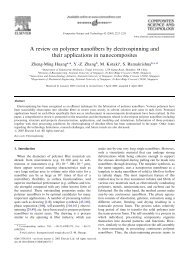

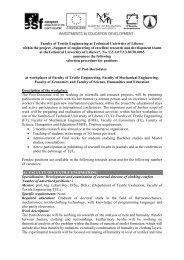
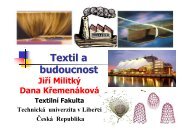
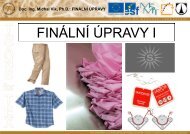

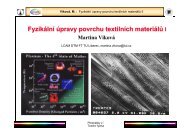
![5 Osvětlení [3 MB]](https://img.yumpu.com/50358472/1/190x134/5-osvetleni-3-mb.jpg?quality=85)
